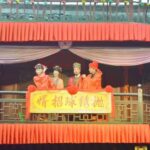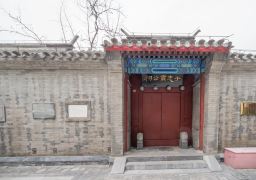Zhen Jun Dian, originally known as Shi Zhen Ren Miao during the Ming Dynasty, was constructed in honor of Zong Ze, a renowned general from the Song Dynasty who resisted the Jin Dynasty. Zong Ze was celebrated for his 13 victories against the Jin forces, striking fear into their hearts. In the 30th year of the Guangxu era (1904 AD), the temple was reconstructed with public donations, taking four years to complete. Over 50 halls were built, creating an imposing and well-planned architectural complex with exquisite details. Today, it serves as a temple that blends both Buddhist and Taoist traditions, welcoming worshippers from both faiths.
Inside the main hall of Zhen Jun Dian, Zong Ze, the True Lord Emperor, is depicted in a red robe with a long beard, his eyes piercing and his righteous aura palpable. The main hall is designed in the Fenghuo Mountain style, spanning three bays in both width and depth. A remarkable feature is the 4.3-meter high and 0.5-meter diameter pan-dragon stone pillar, with its sinuous dragon body interspersed with carvings of the Eight Immortals crossing the sea, depicted with delicate detail and vivid imagery. Other wood, brick, and stone carvings within the hall are meticulously crafted and worthy of close examination. The walls on either side of the rear entrance of the main hall display lifelike figures from the Three Kingdoms and Water Margin, as well as floral patterns, all executed with a graceful and elegant style. These ubiquitous carvings add a touch of softness to the solemn palace. Like most Taoist temples, Zhen Jun Dian also houses the Hall of the Sixty Jia-Zi, the God of Wealth Hall, the Thousand Buddhas Hall, the Lady Hall, and the Guanyin Hall. The opening hours are subject to the daily operational status of the temple.Zhen Jun Dian: A Majestic Temple of Dual Buddhist and Taoist Influence
Zhen Jun Dian, originally known as Shi Zhen Ren Miao during the Ming Dynasty, was constructed in hon[...]









